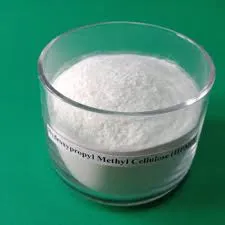
Jul . 27, 2024 11:02 Back to list
Exploring the Benefits and Applications of Hydroxypropyl Methylcellulose in Various Industries
Hydroxypropyl Methylcellulose (HPMC) A Versatile Hydrocolloid in Modern Applications
Hydroxypropyl methylcellulose (HPMC) is a non-ionic, water-soluble polymer derived from cellulose, a natural polymer obtained from the cell walls of plants. HPMC has gained significant recognition in various industrial sectors due to its unique properties, which include excellent thickening, binding, and film-forming capabilities. Over the years, its applications have expanded from traditional uses in pharmaceuticals to a wide array of industries, including food, construction, and cosmetics.
Hydroxypropyl Methylcellulose (HPMC) A Versatile Hydrocolloid in Modern Applications
In the food industry, HPMC is utilized as a food additive, serving multiple functions such as a thickening agent, emulsifier, and stabilizer. Its ability to form gels and enhance texture makes it an essential ingredient in a wide variety of food products, including ice creams, sauces, and baked goods. Additionally, HPMC can be used to modify the rheological properties of food, improving mouthfeel and overall sensory experience. With the growing trend towards vegetarian and vegan diets, HPMC also serves as an egg substitute in various recipes, appealing to a broader consumer base seeking plant-based alternatives.
hpmc hydroxypropyl methylcellulose

Another significant application of HPMC is in the construction industry, where it is incorporated into cement-based products such as mortars, plasters, and adhesives. HPMC enhances the workability of these materials, allowing for easier application and improving adhesion to substrates. Furthermore, HPMC improves water retention in mortars, which is critical for ensuring proper hydration during the curing process. This application is particularly valuable in regions with hot and arid climates where rapid evaporation can compromise the strength and durability of construction materials.
In the cosmetic and personal care industry, HPMC functions as a thickening and stabilizing agent in lotions, creams, and shampoos. Its ability to create a desirable texture and maintain product stability makes it an essential ingredient in various formulations. Additionally, HPMC can enhance the visual appeal of cosmetic products by providing a smooth and silky feel, which can significantly influence consumer preferences.
Despite its widespread utility, the production of HPMC must be approached with consideration for environmental impact. As interest in sustainable materials grows, researchers are exploring greener production methods and assessing the lifecycle of HPMC to minimize its carbon footprint. Innovations in cellulose modification and bio-based alternatives are being developed to ensure that HPMC continues to meet modern demands while adhering to environmental standards.
In conclusion, hydroxypropyl methylcellulose (HPMC) exemplifies the versatility and functionality of cellulose derivatives across various industries. Its applicability in pharmaceuticals, food, construction, and cosmetics underscores its importance as a vital ingredient in countless formulations. As industries evolve and demand sustainable solutions, HPMC is poised to remain a key player in the development of innovative products that cater to both consumer needs and environmental considerations. The future of HPMC looks promising as research continues to unlock its potential in new and diverse applications.
-
What is HPMC?
NewsJun.06,2025
-
Understanding Redispersible Powder: The Future of Construction Materials
NewsJun.06,2025
-
Understanding RDP Powder: The Ultimate Solution for Your Construction Needs
NewsJun.06,2025
-
Pure HPMC: The Ideal Solution for Modern Construction and Building Materials
NewsJun.06,2025
-
Methyl Hydroxyethyl Cellulose: A Versatile Chemical Compound
NewsJun.06,2025
-
Hydroxyethyl Cellulose Power: The Essential Chemical for Various Industries
NewsJun.06,2025







